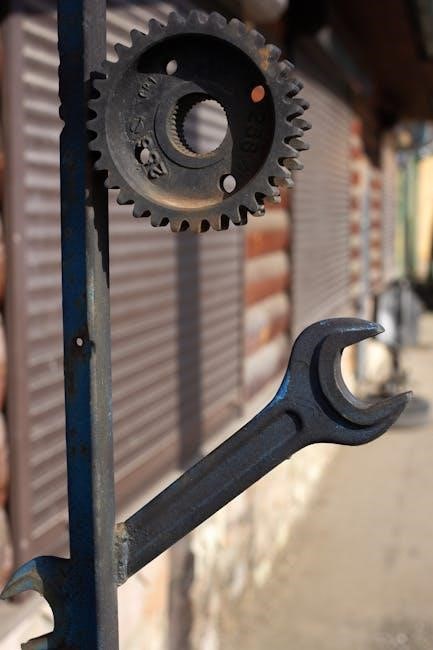Plumbing tools are essential for installing, maintaining, and repairing plumbing systems. These tools enable plumbers to handle pipes, fixtures, and appliances efficiently. From wrenches to pipe cutters, each tool serves a specific purpose. Understanding the names and uses of these tools is crucial for both professionals and DIY enthusiasts. This section introduces the fundamental tools used in plumbing, highlighting their importance in ensuring safety and precision in various plumbing tasks.

Essential Plumbing Tools
Essential plumbing tools are vital for any plumbing task, ensuring efficiency and precision. Common tools include wrenches, pliers, pipe cutters, and drain snakes. Wrenches, like pipe and adjustable wrenches, are used for tightening and loosening pipes. Pliers help grip small objects, while pipe cutters and hacksaws are used for cutting pipes. Drain snakes clear clogs, and tubing cutters handle plastic or metal tubes. These tools are indispensable for both professionals and DIY enthusiasts, aiding in various plumbing repairs and installations.
2.1 Wrenches
Wrenches are among the most fundamental tools in plumbing, designed to grip and turn pipes, fittings, and fixtures. They are essential for tightening, loosening, and adjusting various plumbing connections. Plumbers rely heavily on wrenches due to their versatility and effectiveness in handling different types of pipes and materials.
Types of Wrenches
Several types of wrenches are commonly used in plumbing, each serving a specific purpose. The pipe wrench is a heavy-duty tool with adjustable jaws, ideal for gripping and turning large pipes. It is particularly useful for working with metal pipes in tight spaces. Another popular type is the adjustable wrench, which features a movable jaw that can be set to various sizes, making it versatile for bolts, nuts, and smaller pipes.

Basin wrenches are specialized tools used for reaching and adjusting faucets and other fixtures in confined areas, such as under sinks. Faucet keys, on the other hand, are small, T-shaped wrenches used to turn shut-off valves or operate specific types of faucets. These tools highlight the diversity of wrenches tailored to different plumbing tasks.
Importance of Wrenches in Plumbing
Wrenches are indispensable in plumbing due to their ability to apply significant torque, which is necessary for loosening corroded or over-tightened connections. They also provide a secure grip on slippery surfaces, reducing the risk of damage to pipes or fittings. Whether it’s a pipe wrench for heavy-duty tasks or an adjustable wrench for precision work, these tools are central to a plumber’s toolkit.
2.1.1 Pipe Wrench
The pipe wrench is one of the most essential tools in plumbing, specifically designed for gripping and turning pipes, fittings, and connectors. It is a heavy-duty tool that plays a crucial role in various plumbing tasks, making it a must-have in every plumber’s toolkit. The pipe wrench is particularly useful for working with metal pipes, as it provides the necessary leverage to loosen corroded or over-tightened connections.
One of the standout features of a pipe wrench is its adjustable jaw, which allows it to accommodate different pipe sizes. This versatility makes it an indispensable tool for both residential and commercial plumbing projects; The long handle of the wrench provides extra grip and torque, enabling plumbers to apply significant force when needed. Additionally, the jaw mechanism ensures a secure hold on the pipe, reducing the risk of slippage and potential damage to the pipe or surrounding fixtures.
Pipe wrenches are commonly used for tasks such as installing or removing pipes, tightening loose connections, and repairing leaks. They are especially effective in tight spaces where other tools may not fit. The durability of a pipe wrench is another key advantage, as it is typically constructed from high-quality materials like steel, ensuring longevity even with frequent use.
There are various sizes of pipe wrenches available, catering to different pipe diameters and plumbing scenarios. Plumbers often keep multiple sizes on hand to ensure they are prepared for any situation. In summary, the pipe wrench is a fundamental tool that offers the strength and precision needed to handle a wide range of plumbing tasks efficiently.
2.1.2 Adjustable Wrench
The adjustable wrench is another indispensable tool in the plumbing toolkit, offering versatility and adaptability for a wide range of tasks. Unlike fixed-size wrenches, the adjustable wrench allows plumbers to modify its jaw size to fit various bolt and nut sizes, making it a highly practical choice for diverse plumbing scenarios. This tool is particularly useful when working with different types of fixtures, pipes, and connectors that may require different sizes of wrenches.

One of the key features of the adjustable wrench is its sliding jaw, which can be adjusted by turning a worm gear. This mechanism enables the wrench to securely grip objects of varying diameters, ensuring a firm hold and reducing the risk of slippage. The ergonomic design of the adjustable wrench also provides comfort during prolonged use, making it easier to apply the necessary force without causing fatigue.
The adjustable wrench is commonly used for tightening and loosening bolts, nuts, and fittings in plumbing systems. It is especially handy in situations where access is limited, as its compact size allows it to fit into tight spaces. Additionally, the adjustable wrench is useful for gripping round or hexagonal objects, making it a versatile tool for both plumbing and general handyman tasks.
While the adjustable wrench is incredibly useful, it is important to use it correctly to avoid damaging the tool or the objects it is gripping. Over-tightening the jaw can lead to wear and tear, so it is essential to adjust it carefully. Regular maintenance, such as cleaning and lubricating the moving parts, will also extend the tool’s lifespan and ensure optimal performance.
2.2 Pipe Work Tools
Pipe work tools are essential for any plumbing task, enabling plumbers to cut, shape, and assemble pipes efficiently. These tools are designed to handle the physical demands of working with various types of pipes, ensuring precise and durable connections. Whether it’s cutting, bending, or threading pipes, the right pipe work tools are indispensable for achieving professional results.
One of the most commonly used pipe work tools is the hacksaw, which is ideal for cutting through metal and plastic pipes. Its serrated blade allows for clean, straight cuts, making it a fundamental tool for any plumbing project. Another essential tool is the tube cutter, which is specifically designed for cutting copper and plastic tubing without causing damage to the pipe’s inner surface. This tool is particularly useful for precise cuts in tight spaces.
In addition to cutting tools, pipe work tools also include devices for shaping and preparing pipes. For instance, a pipe bender is used to create smooth, kink-free bends in pipes, which is crucial for maintaining proper water flow and system efficiency. Similarly, a pipe threader is used to create threads on the ends of pipes, ensuring a secure and leak-proof connection when installing fittings and valves.
Other pipe work tools include pliers for gripping and twisting pipes, and pipe wrenches for tightening or loosening pipe fittings. These tools are designed to provide a firm grip on pipes, reducing the risk of slippage and damage. Additionally, pipe vises are used to hold pipes securely in place while cutting or threading, ensuring accuracy and safety during the process.
Understanding the proper use and maintenance of pipe work tools is vital for achieving successful plumbing outcomes. Regular lubrication of moving parts, proper storage, and timely replacement of worn components can extend the lifespan of these tools. By mastering the use of pipe work tools, plumbers can tackle a wide range of tasks with confidence and precision, ensuring reliable and long-lasting plumbing systems.
2.2.1 Hacksaw
The hacksaw is one of the most essential pipe work tools in plumbing, designed specifically for cutting through pipes, tubes, and other materials. It is a handheld saw with a flexible blade that is tensioned to ensure precise and clean cuts. The hacksaw is widely used by plumbers and DIY enthusiasts alike due to its versatility and effectiveness in handling various types of pipes, including metal, plastic, and PVC.
The hacksaw consists of a rectangular or D-shaped frame that holds the blade in place. The blade, typically made of high-carbon steel, features serrated edges that are designed to cut through tough materials. The number of teeth per inch (TPI) on the blade varies, with higher TPI blades being better suited for cutting thinner materials and lower TPI blades for thicker pipes. This adaptability makes the hacksaw a go-to tool for a wide range of plumbing tasks.
Using a hacksaw requires proper technique to achieve clean and accurate cuts. The user should hold the saw firmly, ensuring the blade is straight and aligned with the cutting line. A steady back-and-forth motion is applied, with gentle pressure to avoid breaking the blade. It’s important to maintain the blade’s sharpness, as a dull blade can lead to uneven cuts and increased effort. Regularly replacing worn blades is crucial for optimal performance.
In addition to cutting pipes, the hacksaw can also be used for cutting through bolts, nuts, and other hardware when necessary. Its portability and ease of use make it a must-have tool for any plumber’s toolkit. Whether working on a residential or commercial plumbing project, the hacksaw’s reliability ensures that plumbers can complete tasks efficiently and effectively.
2.2.2 Tube Cutter
The tube cutter, also known as a tubing cutter, is a specialized plumbing tool designed to cut through tubes and pipes with precision and ease. It is an essential tool for plumbers and DIY enthusiasts, particularly when working with smaller diameter tubes made of materials like copper, PVC, or PEX. Unlike hacksaws, tube cutters leave a clean, burr-free edge, making them ideal for professional results.

Tube cutters are available in both manual and powered versions, with manual being the most common for everyday plumbing tasks. The tool consists of a durable frame with a sharp cutting wheel and an adjustable jaw that clamps onto the tube. To use a tube cutter, the user places the tube between the tool’s jaws, tightens it securely, and rotates the cutter around the tube while applying gentle downward pressure. This action scores the tube, and with a few rotations, the tube can be snapped cleanly at the marked point.
There are different types of tube cutters available, including rotary, pipe, and tube cutters. Each type is designed for specific materials and diameters, ensuring versatility for various plumbing projects. For instance, rotary cutters are particularly effective for cutting through copper and plastic tubes, while pipe cutters are better suited for larger, thicker pipes. Plumbers often carry multiple sizes of tube cutters to accommodate different tube diameters.
The key advantage of using a tube cutter is the ability to make precise, clean cuts without causing damage to the surrounding material. This is especially important when working with sensitive or expensive materials. Additionally, tube cutters are safer to use than hacksaws, as they minimize the risk of uneven cuts or accidental nicks. However, proper use is essential to avoid slipping and ensure a clean cut.
Regular maintenance of the tube cutter is necessary to maintain its effectiveness. The cutting wheel should be lubricated periodically and replaced when it becomes dull or worn out. Proper care ensures that the tool remains functional and continues to deliver precise cuts for years to come.



